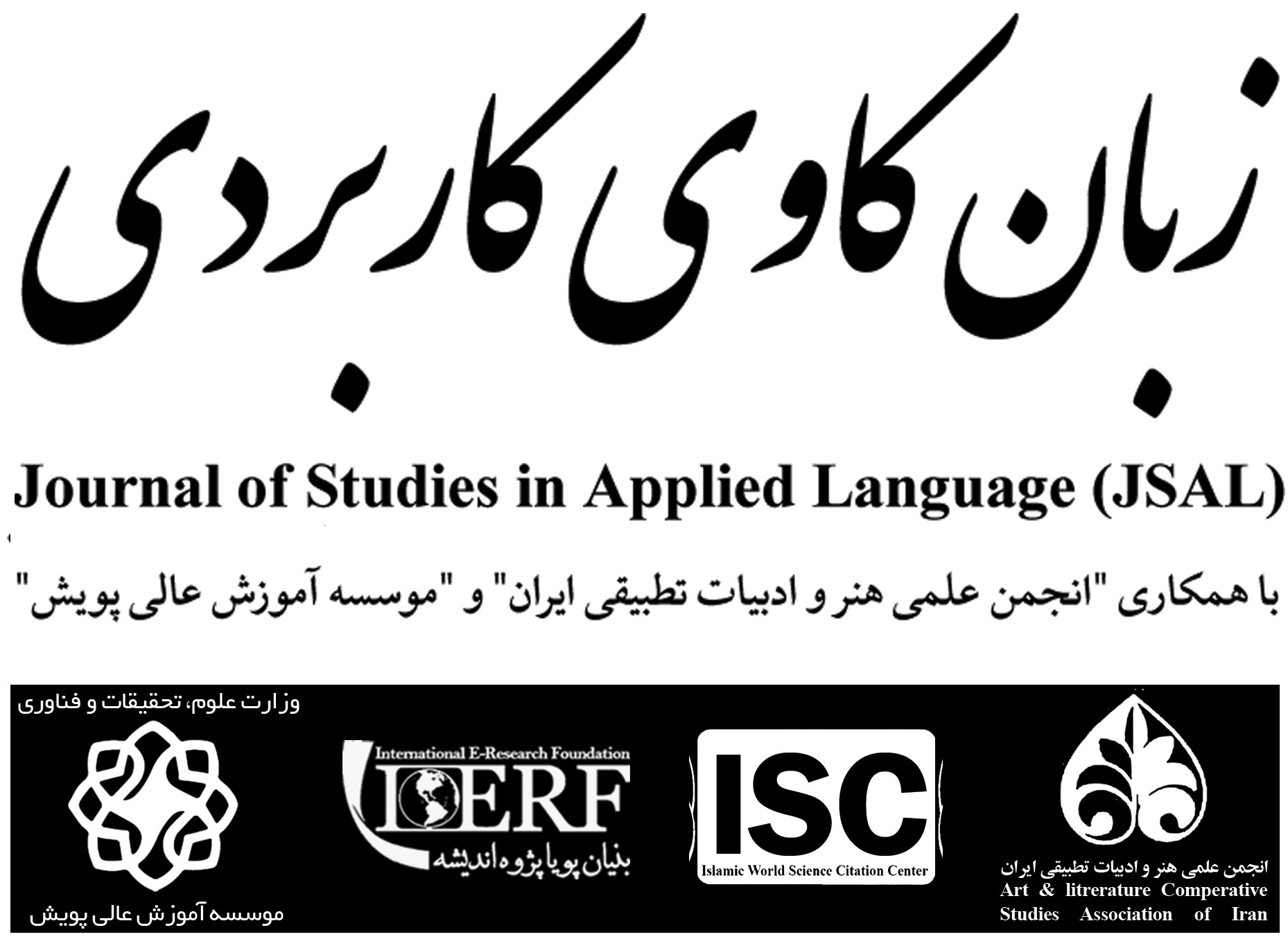دوره 6، شماره 3 - ( 5-1402 )
جلد 6 شماره 3 صفحات 83-53 |
برگشت به فهرست نسخه ها
Download citation:
BibTeX | RIS | EndNote | Medlars | ProCite | Reference Manager | RefWorks
Send citation to:



BibTeX | RIS | EndNote | Medlars | ProCite | Reference Manager | RefWorks
Send citation to:
Kadkhodaei M S, Najafi Ayuki A, Rasulnia A H, Madani A H. (2023). The Application of Metaphorical Structures of “Love” Concept in the Nahj Al-Balagheh Based on Likaff and Johnson’s Theory [In Persian]. JSAL. 6(3), 53-83. doi:10.61186/jsal.6.3.53
URL: http://jsal.ierf.ir/article-1-89-fa.html
URL: http://jsal.ierf.ir/article-1-89-fa.html
کدخدایی مرضیه سادات، نجفی ایوکی علی، رسول نیا امیر حسین، مدنی امیرحسین.(1402). کاربست ساختارهای استعاری مفهوم «عشق» در نهجالبلاغه بر مبنای نظریۀ لیکاف و جانسون زبان کاوی کاربردی 6 (3) :83-53 10.61186/jsal.6.3.53
1- دانشجوی دکتری گروه زبان و ادبیات عربی، دانشکده علوم انسانی، دانشگاه کاشان، کاشان، ایران
2- دانشیار گروه زبان و ادبیات عربی، دانشکده علوم انسانی، دانشگاه کاشان، کاشان، ایران ،najafi.ivaki@yahoo.com
3- دانشیار گروه زبان و ادبیات عربی، دانشکده علوم انسانی، دانشگاه کاشان، کاشان، ایران
4- دانشیار گروه زبان و ادبیات فارسی، دانشکده علوم انسانی، دانشگاه کاشان، کاشان، ایران
2- دانشیار گروه زبان و ادبیات عربی، دانشکده علوم انسانی، دانشگاه کاشان، کاشان، ایران ،
3- دانشیار گروه زبان و ادبیات عربی، دانشکده علوم انسانی، دانشگاه کاشان، کاشان، ایران
4- دانشیار گروه زبان و ادبیات فارسی، دانشکده علوم انسانی، دانشگاه کاشان، کاشان، ایران
چکیده: (2818 مشاهده)
از دیدگاه زبانشناسی شناختی، استعاره نه یک فرایند زبانی صرف، بلکه با اندیشه و تفکر انسان در پیوند است و از رهگذر آن میتوان با شیوۀ اندیشۀ صاحب سخن آشنا شد. مهمترین کارکرد شناختی استعاره، فراهم ساختن درک یک مفهوم انتزاعی از طریق مفهومی ملموستر است؛ از این رو در تبیین مفاهیم عرفانی نقش بسزایی دارد. یکی از موضوعات مهم و اساسی در متون دینی مفهوم «عشق» است که به دلیل انتزاعی بودن در بیشتر مواقع در چارچوب استعارههای مفهومی بیان شده است. حضرت علی (ع) نیز در نهجالبلاغه از این هنرسازه به عنوان ابزاری برای درک مفاهیم انتزاعی استفاده کردهاند؛ به همین دلیل پژوهش حاضر با اتخاذ رویکرد کیفی و روش توصیفی- تحلیلی آن دسته از عبارات استعاری را که دربردارندۀ مفهوم «عشق» هستند از خطبههای نهجالبلاغه استخراج و بر اساس نظریۀ استعارۀ شناختی مورد تحلیل و بررسی قرار داده است. استعارۀ مفهومی از جهات گوناگون دستهبندی شدهاند که در دستۀ اول، استعارهها از نظر نقش، به ساختاری، هستیشناختی و جهتی و در دستۀ دوم، از نظر ماهیت به استعارههای گزارهای، تصویری – طرحوارهای و تصویری مورد بررسی قرار می گیرد. بنابر این بررسی، نتایج تحقیق حاکی از آن است که امام علی(ع) مفهوم انتزاعی «عشق» را در قالب استعارههای شناختی، طرحوارهها و حوزههای مقصد عینی و ملموس برای مخاطب قابل درک ساخته است. در استعارههای ساختاری با استفاده از حوزههای مبدأ «حجاب»، «بیماری»، «کالا» و «شیء» مفهوم عشق را برای مخاطب ترسیم کرده است. استعارههای هستیشناختی در تبیین مفهوم «عشق» و جملات دال بر آن تأثیر بسزایی دارد؛ ایشان با شئانگاری مفاهیم انتزاعی، سعی در تثبیت معنای آن در ذهن مخاطب دارد، گاه از توصیف بهره می گیرد و گاه به جان پنداری روی می آورد. وی در مفهومسازی «عشق» از طرحوارۀ حجمی استفاده نموده و محبت الهی نهادینه شده در وجود فرشتگان را به عنوان مظروف جام عشق معرفی کرده و در جایی دیگر مفهوم «هدایت» را همانند مکانی تصور نموده که دروازههای آن برای ورود عاشقان باز است و افراد باید از این فرصت استفاده کنند و قبل از بسته شدن درگاه، وارد فضای رحمت الهی شوند و در مسیر هدایت قرار گیرند. امام (ع) در طرحوارۀ حرکتی، با استفاده از حرکت که از رفتارهای عینی و اجتنابناپذیر هر شخص برای انجام امور روزانه است، به تبیین مفهوم «عشق» میپردازد؛ بدین ترتیب که با تصویرسازی «خداوند» در قالب مکان، عاشقان وصال حق را از طریق جهاد و مبارزه که وسیلهای برای رسیدن به معبود واقعی است، تشویق به گام برداشتن و حرکت در مسیر رستگاری میکند.
واژههای کلیدی: مفهوم عشق، زبانشناسی شناختی، استعارۀ مفهومی، ساختارهای استعاری، نظریۀ لیکاف و جانسون
نوع مطالعه: پژوهشي |
موضوع مقاله:
تحلیل گفتمان
دریافت: 1402/3/5 | پذیرش: 1402/4/18 | انتشار: 1402/5/8
دریافت: 1402/3/5 | پذیرش: 1402/4/18 | انتشار: 1402/5/8
فهرست منابع
1. Ibn Manzoor, (1988), Lesan Al-Arab, explanation: Ali Shiri, Al-Tabbah al-Awli, 1th edition, Beirut: Dar ehya al-Torath al-Arabi. [In Arabic]
2. Ardabili, L., (2012), Introduction to Cognitive Anthropology, History of Development of Concepts and Theories, 1th Edition, Tehran: Science Publishing. [In Persian]
3. Arasto., (2007), Botiga, translated by: Helen Olyainia, 1th edition, Isfahan: Farda Publications. [In Persian]
4. Estilami, M., (2018), Dictionary of Sufism and Mysticism, 1th edition, Tehran: Farhang Masazer Publications. [In Persian]
5. Eco, E., (2004), Metaphor based on thinking and tools of beauty creation, translation: Sassani and group of translators, 1th edition, Tehran: Surah Mehr Publications. [In Persian]
6. Amedi, A., (1990), Ghorar Al-Hekam and Dorar Al-Kalam, Edited by Seyyed Mahdi Rajaee, Qom: Dar Al-Kitab Al-Islami Publications. [In Arabic]
7. Barcelona, A., (2011), Metaphor and permission with a cognitive approach, translated by: Farzan Sojodi and others, 1th edition, Tehran: Naqsh Jahan publications. [In Persian]
8. Bahrani, K., (1996), Commentary on Nahj Al-Balaghe; Mashhad: Islamic Research Foundation. [In Persian]
9. Tahanwi, M., (1862), Kashaf Al-Funun terminology, edited by: Al-Molawi Mohammad Wahida, Al-Molawi Abdul Haq, Al-Molawi Gholam Qadir. [In Arabic]
10. Taylor, J., (2004), Expansion of the permissible category and metaphor, translated by Maryam Saberi Noori Pham in the book Metaphor is the basis of thinking and a tool for creating beauty, the group of translators under the effort of Farhad Sassani, 1th edition, Tehran: Mehr Publications. [In Persian]
11. Jurjani, A., (1991), Asrar Al-Balaghe, explanation: Mahmoud Mohammad Shakir, 1th edition, Jeddah: Dar Al-Madani Publications. [In Arabic]
12. Davari Ardakani, R., (2012), Metaphorical language and conceptual metaphors, 1th edition, Tehran: Hermes Publications.
13. Dashti, Mohammad, (2000), Translation of Nahj al-Balaghe, 1th edition, Qom: Asr Zahoor Publications. [In Persian]
14. Rasekh mohannd, M., (2014), An Introduction to Linguistics: Theories and Concepts, 4th edition, Tehran: Samt Publications. [In Persian]
15. Ragheb Esfahani, H., (1991), Al-Mufardat fi Gharib al-Qur'an, 1th edition, Beirut: Dar Al-Elam Publications. [In Arabic]
16. Zarghani, S. M., & Ayad, M. (2014). "Transformation of metaphor of Love from Sanai to Rumi". Mystical Literature, Vol. 6, No. 11, pp. 43-80. Doi: 10.22051/jml.2015.1924
17. Zarghani, S. M., Mahdavi, M. J., & Abad, M. (2013). "Cognitive Analysis of Love Metaphors in Sanā'ī's Ghazals". New Literary Studies, Vol. 46, No. 4, pp. 1-30. Doi: 10.22067/jls.v46i4.22056
18. Sajjadi, Seyyed Jafar, (1991), Dictionary of Mystical Words and Terms and Interpretations, 1th edition, Tehran: Tahori Library. [In Persian]
19. Saeedi, G., (2013), Dictionary of Ibn Arabi's Mystical Terms, 1th edition, Tehran: Shafi'i Publications. [In Persian]
20. Shafi'i Kodkani, M., (1987), Imagination in Persian poetry, 3th edition, Tehran: Aghah Publications.
21. Safavi, K., (2012), "A discussion about image designs from the perspective of cognitive semantics", Farhangistan Letter, Vol. 6, No. 1, pp. 65-86.
22. Safavi, K., (2004), Descriptive Culture of Semantics, 1th edition, Tehran: Contemporary Culture Publications. [In Persian]
23. Safavi, K., (2012), Scattered writings (First Department: Semantics), 1th edition, Tehran: Scientific Publications.[In Persian]
24. Safavi, K., (2012), An introduction to semantics, 5th edition, Tehran: Surah Mehr Publications. [In Persian]
25. Safavi, K., (2015), Language, Mind and Culture, translated by Jahanshah Mirzabigi, Tehran: Aghat Publications. [In Persian]
26. Safavi, Korosh, (2016), Metaphor, 1th edition, Tehran: scientific publication. [In Persian]
27. Arabi, M. (2019). "Logical Forms of Imam Ali's Arguments for proofing his Succession according to Nahj al-Balagha". Nahjolbalagheh Research, Vol. 17, No. 4, pp. 81-106.
28. Fatuhi, M., (2012), Stylistics, theories, approaches and methods, 2th edition, Tehran: Sokhon publications. [In Persian]
29. Farouzanfar, B., (1960), Description of life and criticism and analysis of the works of Sheikh Farid al-Din Mohammad Attar Neishabouri, Tehran: University of Tehran. [In Persian]
30. Qasimzadeh, H., (2013), Metaphor and Knowledge, 1th edition, Tehran: Arjmand book publications. [In Persian]
31. Ghaemi, M., (2021), An introduction to the system of metaphorical conceptualization in Nahj al-Balaghe, 2th edition, Hamedan: Buali Sina University. [In Persian]
32. Ghaeminia, A., (2011), Cognitive Semantics of the Qur'an, 1th edition, Tehran: Islamic Culture and Thought Research Institute Publishing Organization. [In Persian]
33. Kochesh, Z., (2013), A practical introduction to metaphor, translated by: Shirin Pourabrahim, 1th edition, Tehran: Samt publications. [In Persian]
34. Goharin, S., (1388), Description of Sufism Terms, 1th edition, Tehran: Zovvar Publications [In Persian].
35. Likaff, G., Mark Johnson, (2016), Metaphors that we believe, translated by: Rahele Gandhamkar, 1th edition, Tehran: Scientific Publication. [In Persian]
36. Al-Muttaqi al-Hindi, A., (2009), Kanz Al-Umal fi Sunan Al-Aqwal wa Al-Aqeel, Beirut: Darahiya al-Tarath al-Islami publications. [In Arabic]
37. Makarem Shirazi, N., (2004), Message of Imam Amirul Momineen (AS), Tehran: Daral-e-Kitab al-Islamiyya publications [In Arabic].
38. Maidani N., (1986), Proverbs, research: Mohammad Abolfazl Ebrahim, Beirut: Dar al-Jil publications. [In Arabic]
39. Hashemi, Z. (2010). "Conceptual Metaphor Theory as Proposed by Lakoff and Johnson". Journal of Adab Pazhuhi, Vol. 4, No. 12, pp. 119-140.
40. Hoshangi, H., Mahmoud Seifi (2008) "Conceptual metaphors in the Qur'an from the perspective of cognitive linguistics", Journal of Sciences and Sciences of the Holy Qur'an, Vol. 1, No. 3, pp. pp. 34-9.
41. Johnson, M., (1987), The Bady in the Mind, Chicago: university of Chicago press [In English].
42. Saeed, j., (1997), Semantic, Oxford: blackewll. [In English]
ارسال پیام به نویسنده مسئول
| بازنشر اطلاعات | |
 |
این مقاله تحت شرایط Creative Commons Attribution-NonCommercial 4.0 International License قابل بازنشر است. |








